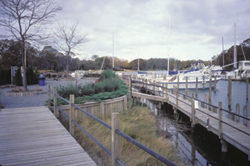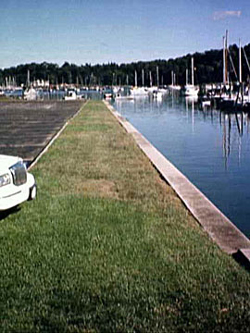New York Sea Grant's
Marina Pollution Prevention Web Site
Section 5: Facility
Management
- Landscaping
Potential Environmental Impacts
Excess pesticides and fertilizer that you put on grassed areas
and plantings can eventually run off into the marina basin and
 harm
marine and aquatic life. Landscaping techniques can be used to
reduce environmental impacts on marina basins and can save money
by requiring less water and maintenance, while creating an attractive
location for customers.
harm
marine and aquatic life. Landscaping techniques can be used to
reduce environmental impacts on marina basins and can save money
by requiring less water and maintenance, while creating an attractive
location for customers.
Best Management
Practices
Use native
plants for landscaping. Plants that are native to the region and
climate compete well with weeds and other pests. They also require
less fertilizer and pest control than non-native plants. Native
plants can be purchased at your local nursery.
Avoid planting
invasive species. Invasive species multiply rapidly and take over
areas very quickly. For more information on invasive species
by state, click
here. Your local Soil and Water Conservation District
or Cooperative Extension Service should also be able to provide
you with information on invasive species specific to your area.
Save water
by watering in the early morning or late afternoon. Oscillating
sprinklers can lose up to 50% of water to evaporation on hot days.
Use composted
fish waste as fertilizer for your plants. See "Fish Waste,"
click here
for more information.
Plant a vegetated
filter strip or buffer between impervious areas and the marina
basin. A vegetated filter strip is a densely vegetated strip of
land engineered to accept runoff from upstream development as
overland sheet flow. For more information on controlling runoff
at your marina, see Stormwater Runoff Management Practices,
click here.
 Minimize
fertilizer use. When it comes to fertilizer, more is not better!
The excess nutrients from unused fertilizer will run off into
the marina basin and potentially cause an algal bloom. Plus, the
more you fertilize, the more frequently you have to mow. Leave
grass clippings on the lawn areas since they act as a natural
organic fertilizer.
Minimize
fertilizer use. When it comes to fertilizer, more is not better!
The excess nutrients from unused fertilizer will run off into
the marina basin and potentially cause an algal bloom. Plus, the
more you fertilize, the more frequently you have to mow. Leave
grass clippings on the lawn areas since they act as a natural
organic fertilizer.
If you must
use fertilizer, apply it in late April and again in September.
If a third treatment is needed, apply in late May. Apply only
a half pound of nitrogen per 1,000 square feet of lawn at each
application. To figure this out, divide 100 by twice the percentage
of nitrogen (N) in the fertilizer. This will give you the application
rate in pounds of fertilizer per 1,000 square feet of lawn.
Regulatory
Issues
Before disposing
of old or unused lawn additives, particularly pesticides, conduct
a hazardous waste determination to establish whether or not their
disposal is subject to hazardous waste regulations. To determine
if waste lawn products are hazardous, the generator must either
have waste materials tested or utilize reliable "knowledge
of process" information for the waste (if available) [40
CFR 262.11, click
here]. Such information could include information
from product labels, testing by haulers, or studies by industry
trade groups. For more information on New York hazardous waste
testing requirements, click
here. If hazardous, waste lawn products must be
managed in accordance with hazardous waste storage and handling
requirements [40 CFR 262.11, click
here]. For more information on New York's Hazardous
Waste Regulations and storage requirements, click
here.

